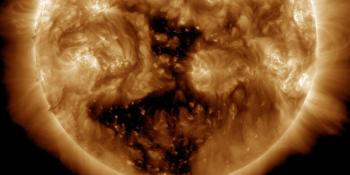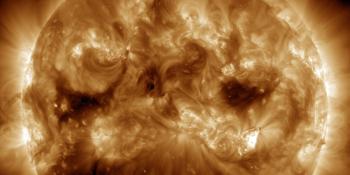Viewing archive of Friday, 15 June 2001
Solar activity report
Any mentioned solar flare in this report has a scaling factor applied by the Space Weather Prediction Center (SWPC). Because of the SWPC scaling factor, solar flares are reported as 42% smaller than for the science quality data. The scaling factor has been removed from our archived solar flare data to reflect the true physical units.
Report of Solar-Geophysical Activity 2001 Jun 15 2200 UTCPrepared by the NOAA © SWPC and processed by SpaceWeatherLive.com
Joint USAF/NOAA Report of Solar and Geophysical Activity
SDF Number 166 Issued at 2200Z on 15 Jun 2001IA. Analysis of Solar Active Regions and Activity from 14-2100Z to 15-2100Z
Solar activity was high due to an M6/1n flare at 1013
UTC from Region 9502 (S25E32). The event was associated with a CME
that was observed to enter the LASCO/C2 field of view at 1031 UTC.
The CME was directed mostly to the southeast but a portion of it
appeared to cross the solar south pole. Region 9502 is not showing
growth, but it does have an east-west inversion line and continues
to produce occasional flares. A subsequent impressive CME was
observed on the west limb in LASCO/C2 images at beginning at 1648
UTC. There were no obvious disk or x-ray signatures, implying that
the CME originated from behind the west limb. Regions 9503 (N15E46)
and 9504 (N07E51) are currently the largest sunspot groups on the
disk but were quiet and stable. Region 9503 is developing some
magnetic complexity. New Region 9507 (N13E26) emerged on the disk
today.
IB. Solar Activity Forecast
Solar activity is expected to be
moderate. Regions 9502 and 9503 are the most likely candidates for
moderate or higher level activity. There is a slight chance for a
major flare event.
IIA. Geophysical Activity Summary 14-2100Z to 15-2100Z
The geomagnetic field was unsettled to slightly active. Solar wind
observations suggest that the activity originated from enhanced
density and interplanetary magnetic fields during a solar sector
boundary crossing. A greater than 10 MeV proton event began today at
1750 UTC. The event appears to have originated from today's
behind-the-limb event. The flux levels are rising slowly, with a
peak flux as of forecast issue time of 23 PFU.
IIB. Geophysical Activity Forecast
The geomagnetic field is
expected to be mostly unsettled for the next 24 hours. An increase
to mostly active is expected on the second day in response to
possible effects from the partial halo of 14 June as well as
possible effects from today's partial halo (associated with the M6
flare). Mostly unsettled levels are expected to prevail on the third
day. The greater than 10 MeV proton event is expected to end
sometime around 15/2400 UTC.
III. Event Probabilities 16 Jun to 18 Jun
| Class M | 65% | 65% | 65% |
| Class X | 10% | 10% | 10% |
| Proton | 99% | 10% | 10% |
| PCAF | in progress | ||
IV. Penticton 10.7 cm Flux
Observed 15 Jun 197 Predicted 16 Jun-18 Jun 200/200/195 90 Day Mean 15 Jun 171
V. Geomagnetic A Indices
Observed Afr/Ap 14 Jun 006/009 Estimated Afr/Ap 15 Jun 010/012 Predicted Afr/Ap 16 Jun-18 Jun 010/010-020/020-010/012
VI. Geomagnetic Activity Probabilities 16 Jun to 18 Jun
| A. Middle Latitudes | |||
|---|---|---|---|
| Active | 30% | 35% | 35% |
| Minor storm | 15% | 20% | 15% |
| Major-severe storm | 05% | 15% | 05% |
| B. High Latitudes | |||
|---|---|---|---|
| Active | 30% | 35% | 30% |
| Minor storm | 15% | 25% | 15% |
| Major-severe storm | 05% | 20% | 10% |
All times in UTC
Latest news
Latest forum messages
Large Coronal Hole 25 127Aurora photography hints for those of us with smartphones 43Photographing auroras 34AR4043 8More on an art than a science 3
More topicsSupport SpaceWeatherLive.com!
A lot of people come to SpaceWeatherLive to follow the Sun's activity or if there is aurora to be seen, but with more traffic comes higher server costs. Consider a donation if you enjoy SpaceWeatherLive so we can keep the website online!

Latest alerts
Wednesday, 26 March 2025
23:00 UTC - Geomagnetic activity
Minor G1 geomagnetic storm (Kp5) Threshold Reached: 22:37 UTC
20:30 UTC - Geomagnetic activity
Moderate G2 geomagnetic storm (Kp6) Threshold Reached: 20:08 UTC
20:15 UTC - Geomagnetic activity
Minor G1 geomagnetic storm (Kp5) Threshold Reached: 20:00 UTC
18:00 UTC - Geomagnetic activity
Moderate G2 geomagnetic storm (Kp6) Threshold Reached: 17:00 UTC
17:00 UTC - Geomagnetic activity
Minor G1 geomagnetic storm (Kp5) Threshold Reached: 16:28 UTC
Space weather facts
| Last X-flare | 2025/02/23 | X2.0 |
| Last M-flare | 2025/03/26 | M1.0 |
| Last geomagnetic storm | 2025/03/22 | Kp6- (G2) |
| Spotless days | |
|---|---|
| Last spotless day | 2022/06/08 |
| Monthly mean Sunspot Number | |
|---|---|
| February 2025 | 154.6 +17.6 |
| March 2025 | 135 -19.6 |
| Last 30 days | 133.8 -19.2 |







